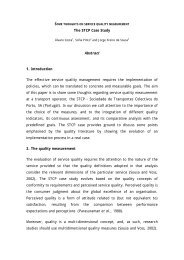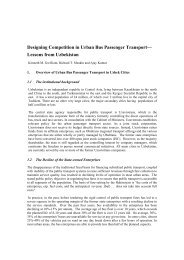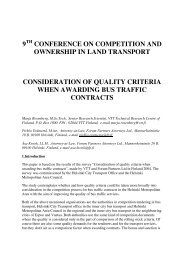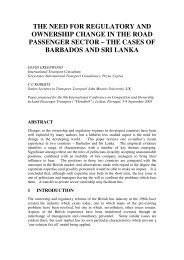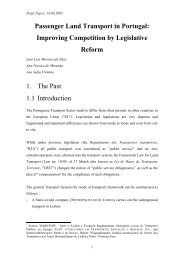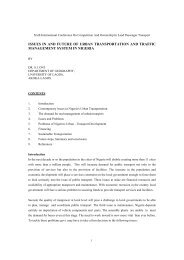1 COMPETITION IN URBAN PUBLIC TRANSPORT AW ORLD VIEW ...
1 COMPETITION IN URBAN PUBLIC TRANSPORT AW ORLD VIEW ...
1 COMPETITION IN URBAN PUBLIC TRANSPORT AW ORLD VIEW ...
Create successful ePaper yourself
Turn your PDF publications into a flip-book with our unique Google optimized e-Paper software.
een cost savings, which vary country to country based upon labor market<br />
conditions.<br />
EUROPE<br />
The European Union (EU) began as a political union. Dating from 1957 with the<br />
Treaty of Roma. It came to symbolise the peace and cooperation of different<br />
nations, just after the Second World War. At first it was a political union, then<br />
transitioning to an economic and monetary union, and then a customs union. In<br />
the last decade, the Treaty of Maastricht (1992, Feb.), laid the foundation stone<br />
of another step, the step of the “real common life”, with his own rules, case laws,<br />
precedents. The “mad cow”disease crisis represented the biggest problem of<br />
this fledgling EU:the gap between a “liberal”policy and a “democratic”vision of<br />
the economy.<br />
France:Public transport is always a matter of contention among political parties.<br />
The 1984 Transportation Act in United Kingdom seems to be for each side either<br />
the worst, or the best, model of deregulation and competition. The French “public<br />
service”inspires the defenders of the welfare state and the local authorities. The<br />
legislative contexts are different, the roles and the functions of the authorities, if<br />
they exist or not, of the companies and of the passengers too.<br />
We will analyse in a first part the French model for transit contracting. We will try<br />
secondly to understand its own evolution, of course in France, but mainly in the<br />
new European policy of regulation. Third, we will take three different examples, in<br />
the south-west French city of Perpignan, actually the one and only network<br />
operated by a non French company, in the German rail network (local and<br />
national)with many French investments, and finally the case of Melbourne,<br />
Australia, strategic place for the development in Asia and Pacific area of the<br />
biggest French operators, private or public.<br />
An important characteristic of transit in France is that there is a clear distinction between<br />
the respective roles of local governments and operators. The “low demand”(insufficient<br />
for commercial operation)for transit is compensated by a “fixed”contribution from the<br />
local government that allows the operator to remain an “entrepreneur”.<br />
The demand of public transport decreased over the years. Until the 1960s, public<br />
transport was profitable in French towns. Demand decreased because of the<br />
high rate of motorization that lead to a reduction of the service supplied soon<br />
followed by their suppression. This motorization phenomenon had happened in<br />
the US before the war, and everywhere in Europe in the 1950s.<br />
In the late 1960s and mainly in the1970s, local government public transport<br />
agencies governments (LTA’s – Local Transit Authorities)assumed responsibility<br />
over public transport. This was made possible by the creation of the public<br />
transport tax (“versement transport”), first in Paris in 1971, and then in the<br />
province areas (a fixed percentage of all wages - between 0,55 and 1,75%, the<br />
highest rate is conditioned by the construction of infrastructure for tramway or<br />
2



